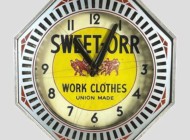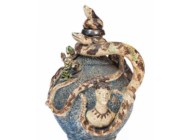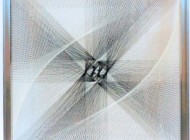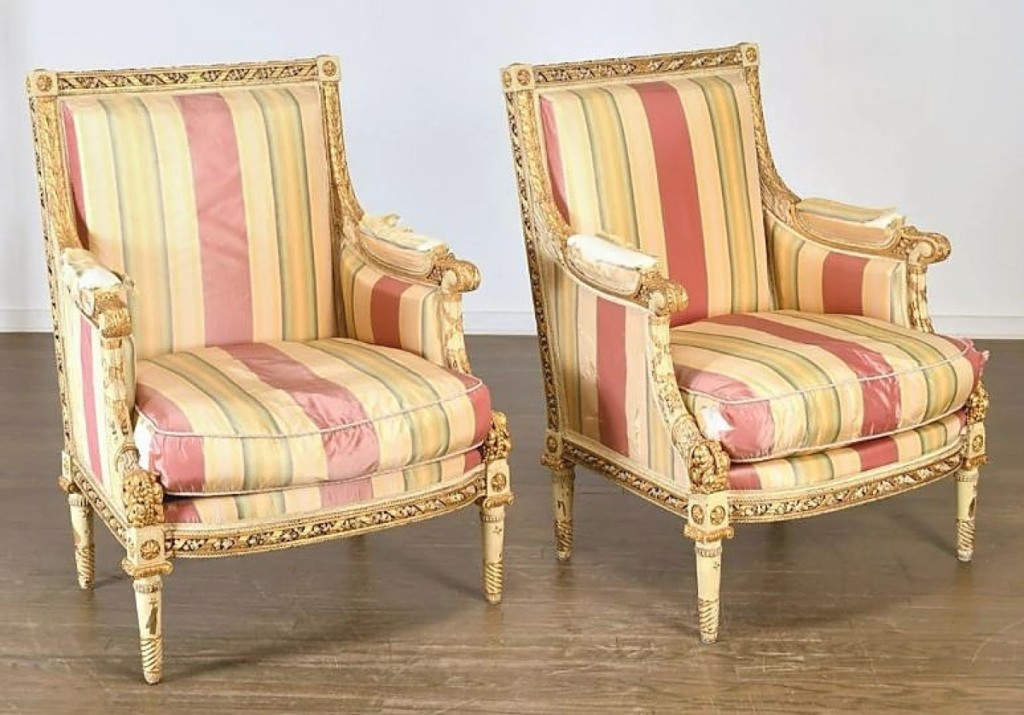
From the collection of Seema Boesky came this pair of Nineteenth Century Empire painted and gilt bergère chairs. The duo sold for $18,750. The auction house had a number of interested parties who wanted to see every square inch of these on the Zoom preview calls — they ultimately sold to a New York City dealer.
Review by Greg Smith, Photos Courtesy Millea Bros Ltd
BOONTON, N.J. – Michael Millea described his firm’s December 8-11 Select Sale in glowing terms.
“It was definitely in our top five of all time, maybe top three,” the co-owner of Millea Bros Ltd said over the phone following the three-day auction’s close. “During the pandemic, people have turned to auctions. There’s no lack of interest. That’s not to diminish the quality of what we had, though, you have to have the stuff people want to buy.”
The stuff was there, pulled from collections near and far, including a Park Ave address; the libraries of art historians; the estate of Dr Leonard Hamilton, a DNA researcher; objects and furniture from the collection of Seema Boesky; Asian arts from the collection of George and Abby O’Neill (Rockefeller), and others.
David Halpern, Millea’s senior cataloger and Twentieth Century specialist, said, “It was really strong everywhere, from real collectible categories like antiquities and modern art to both traditional and contemporary furniture. It was across the board strong.”
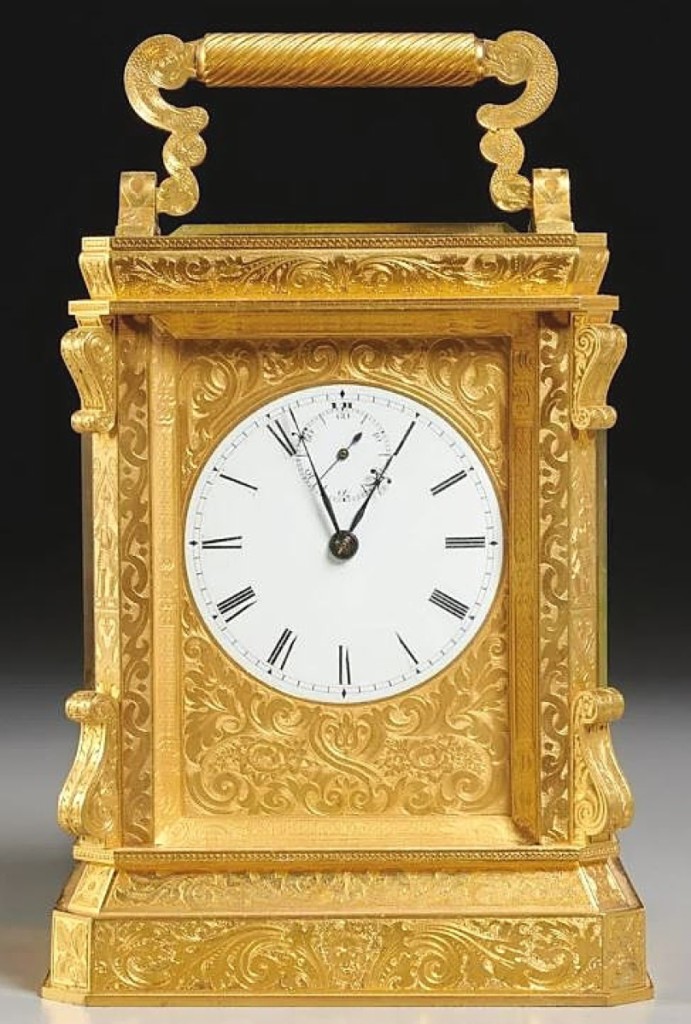
Clock afficionados were buzzing over this early carriage clock by Charles Frodsham. Even with a magnificently engraved foliate gilt-brass case, most of the interest came on account of the works, which were cutting edge technology at the time. This example dated to 1849 and came from the collection of Dr Leonard Hamilton. It sold for $41,250.
To their point, while some surprises were found within the results, the auction was largely on track and above estimate with no far-and-away sleeper rising.
“We usually have some shocking sale, a really simple thrown Chinese bowl or something, but this was an auction where everything performed well,” Millea said. “There was nothing too shocking, just a lot of things that sold well above estimate. I much prefer that, there’s nothing worse than being an auctioneer and having to beg people to buy things. That wasn’t the case here, it was pleasurable to be the auctioneer.”
There was considerable strength among prints and multiples spanning historical etchings to avant-garde photography.
A line of provenance that provided many of them read: “From the Private Library of an Art Historian.”
Halpern noted, “It was a collection built over time, probably in the 1970s and 1980s. They were academics, and they had a lot of close relationships with other academics and artists, they would trade for things with others. Some of this was very esoteric until now.”
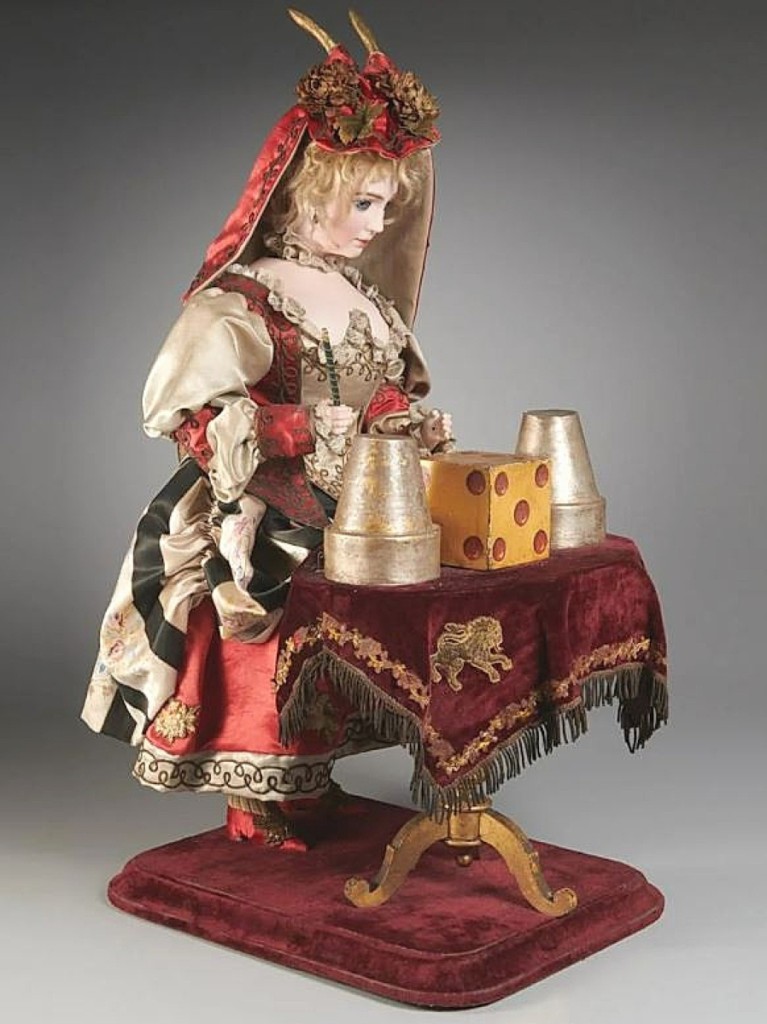
A few automatons in the sale included this musical magician example by Roullet et Decamps. Circa 1880-85, the auction house said it came from a highly esteemed collection of automata. It took $35,000.
Top among them was a group of four Hans Bellmer (German, 1902-1975) hand colored photographs from “Les jeux de La poupee” or “The Game of the Doll,” that sold for $17,500. The series was Bellmer’s second experimentation with a doll, a surrealist adventure, and one that was published as a book in 1949 in an edition of 136.
Surrealist images of dolls, or in this case mannequins, were further explored by Man Ray (American/French, 1890-1976), who provided a lot of ten photographs from 1938 and 1966 that sold for $12,500. Man Ray also provided two photograph portraits of Pablo Picasso, sepia gelatin silver prints on Japan paper, that brought $17,500 and $16,250.
Not many think of Picasso as a photographer, but the multi-disciplinary artist dabbled in the medium for a short time. The auction house was thrilled to present two mono prints from the artist featuring a monkey, where the artist hand etched directly into the negative, a technique known as cliche-verre. The image of a monkey in an environment sold for $12,500, while a more focused image of the same monkey without a background took $11,250, both of these at the low end of the estimate.
Halpern said, “It was really an obscure area for Picasso, and I think it made it hard for us to find these audiences. Other auction houses have handled some, and they too had trouble finding the audience. What’s known of them is they were one-off prints, they’re super rare and each is one of a kind.”
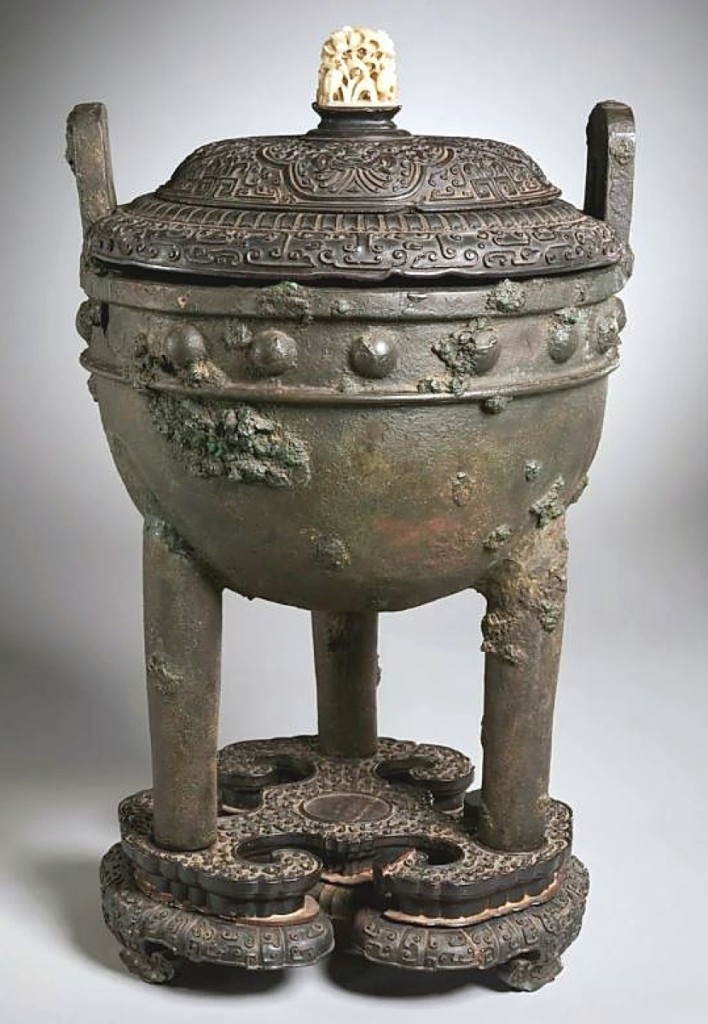
Taking $30,000 was this Chinese archaic-style ritual Ding tripod vessel that the auction house said probably dated to the Western Zhou Dynasty in the Tenth Century BCE. It measured 24 inches high.
Millea said, “In a sale like this where we had really great offerings in photography, we had top photography dealers looking at it. It’s not that they didn’t see it, it’s just an unproven market. No one knows what to make of them. It’s an example where rarity sometimes hurts something. Someday there will be a show and it will raise the profile.”
Also notable in photography was a selection of works from Consuelo Kanaga (American, 1894-1978), a photographer whose recognition has boomed in recent years for her images of African American life in the Great Depression. Taking $13,750 was the circa 1950 silver gelatin print “Mother and Son, (The Question, Florida).” Behind at $7,500 was a circa 1935 portrait of Annie Mae Merriweather in a gelatin silver print.
Five automatons were found in the sale with provenance to a major automata collector. The firm said the interest in them came from a small but devoted group of collectors who seek the best examples. What they found was a $35,000 result for a Roullet et Decamps musical magician automaton, a French example dating to 1880-85. Behind at $22,500 was a musical clown automaton by Gustave Vichy, 40¼ inches tall.
Millea offered 124 lots from the collection of Dr Leonard Hamilton, including etchings and lithographs by James A.M. Whistler, Chinese jade bi discs, English silver, a wide variety of lithographs from modern artists, bronze sculpture and clocks and watches. It was that latter category of clocks that had bidders ticking when a Charles Frodsham carriage clock, circa 1849, sold for $41,250. The auction house said interest came from far and wide on the example, including the company that made it, which is still in business today, as well as the dealer who sold it into Hamilton’s collection over 40 years ago.
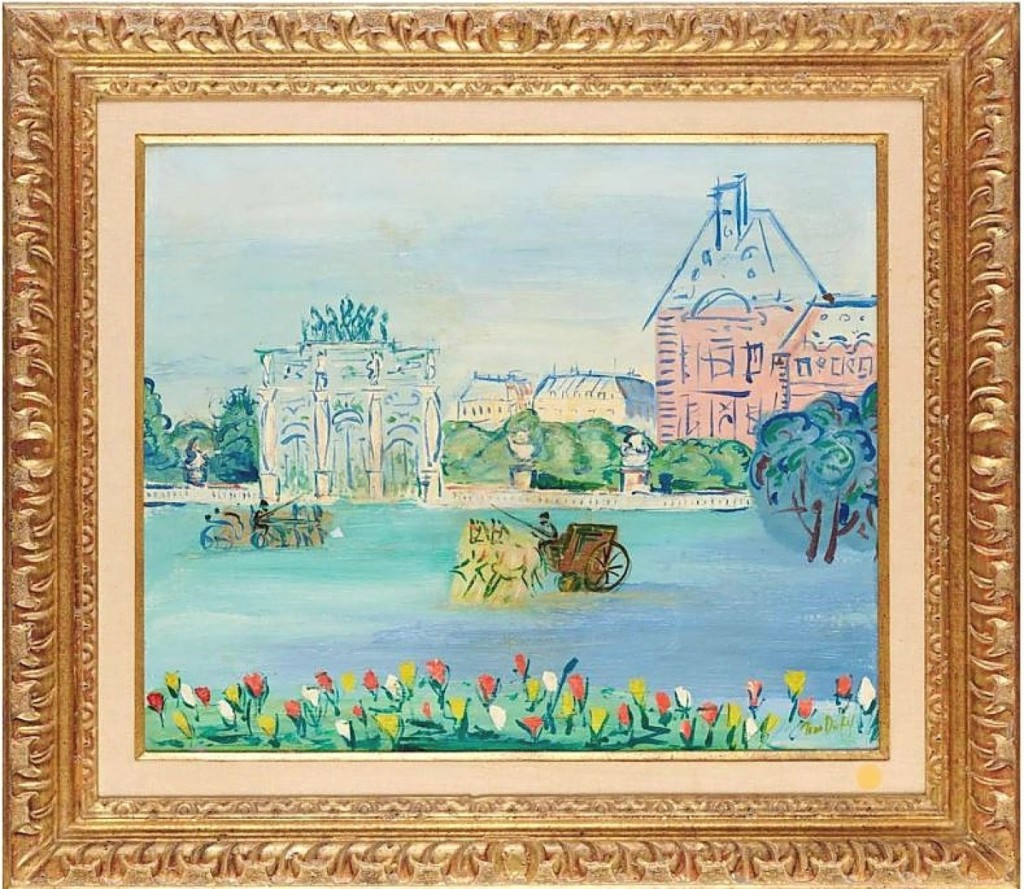
Among the top paintings in the sale was this oil on canvas by Jean Dufy, “Jardin des Tuileries et l’Arc de Triomphe Du Carrousel,” which sold for $25,000. It measured 18 by 22 inches.
“We always offer everything as is, but Dr. Hamilton’s clocks were so special that people were frustrated we didn’t have more information, so we got a specialist in to get them running and the bidders really appreciated that,” Halpern said. “These are really early and they must have been like computers of their day. They were cutting edge for the time.”
Millea noted the craftsmanship: a foliage engraved gilt-brass gorge case, beveled crystal panes and the white enameled clock face with black Roman numerals.
From the same collection was another English carriage clock in a foliate engraved gilt-brass gorge case, this example by Barraud & Lunds, circa 1845, that sold for $13,750. By English maker James McCabe came a carriage clock with its mahogany travel case, circa the 1840s, that sold for $16,250.
In a sale that featured both modern and traditional furniture, it seemed that the traditional examples found greater favor. A New York City dealer paid $18,750 for a pair of Nineteenth Century Empire painted and gilt bergère chairs from the collection of Seema Boesky.
Halpern said, “We did a lot of Zoom previewing, many for the clocks and automata. These chairs were the one piece where we had to zoom every inch of it for numerous people, showing joining and everything. These are significant, period chairs.”
The chairs featured an old inventory number along the inside of the seat rail and were thought to be originally fully gilt.
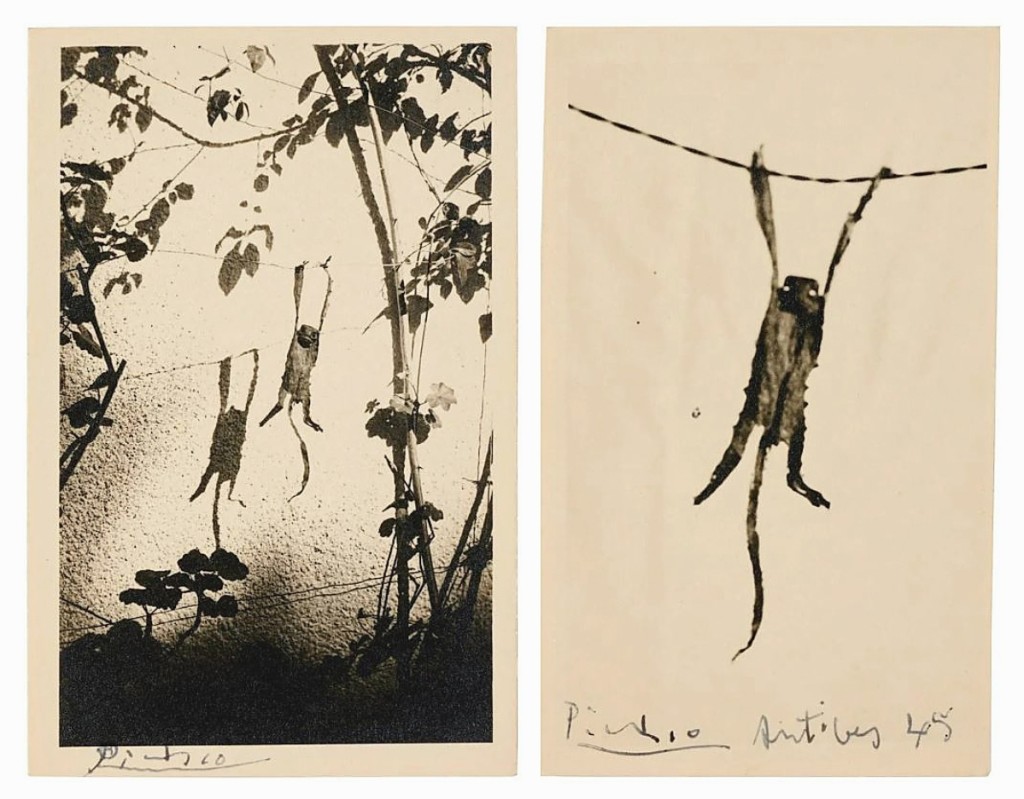
Two etched photo mono prints by Pablo Picasso were found in the sale. The example at left brought $12,500, while the one on the right took $11,250. Picasso’s photographic works are quite rare, and in these, he etched onto the negative in a process known as cliche-verre.
At $21,250 was a pair of mahogany French bergère chairs by Eugene Printz, circa 1928. An identical pair was illustrated in Guy Bujon & Jacques Dutch’s 1986 title E. Printz. A pair of oak benches by George Bullock would also rise above estimate, taking $17,500. Circa 1815, the English pair featured reeded armrests and legs with a scalloped seat rail with molded half-roundels.
If there was any one category that did actually produce a number of surprises, it was in the antiquities. Rising to $20,000 was a carved medallion that the firm believed to be Egyptian, measuring 2¼ inches in diameter and featuring a relief carved scene of an ibis and cat drinking from a vessel. This and others came from a private collection in Bergen County, N.J., many of which were earlier purchased at Parke-Bernet.
On a number of Egyptian faience ushabtis in the sale, Millea said, “They had incredible color. So many of these are washed out and muddy, but these were really vibrant turquoise and the black markings were really well defined.”
Pharaoh among them was a $10,000 result for a 6½-inch-high example that had museum accession numbers on it. The form featured a servant for the afterlife and possibly dated to the Third Intermediate Period (1069-945 BCE). Taking $6,875 was a lot of two ushabti figures, both in the same bright blue faience.
The sale would not have been complete without paintings, where an example from Jean Dufy (French, 1888-1964) and a work attributed to William Merritt Chase (American, 1849-1916) both went out at $25,000. The Dufy, an 18-by-22-inch oil on canvas, was titled “Jardin des Tuileries et l’Arc de Triomphe Du Carrousel” and came from an Upper East Side, Manhattan, collection. The Chase oil on canvas featured a woman in a field and had been sold and reneged on by a buyer in the firm’s June sale when it brought $7,500. It took considerably more this round, with the firm saying the underbidders from the last bout were still interested, as well as new parties.
For additional information, www.milleabros.com or 973-377-1500.


























